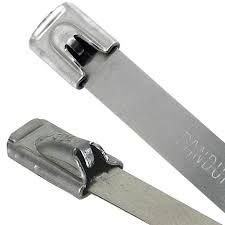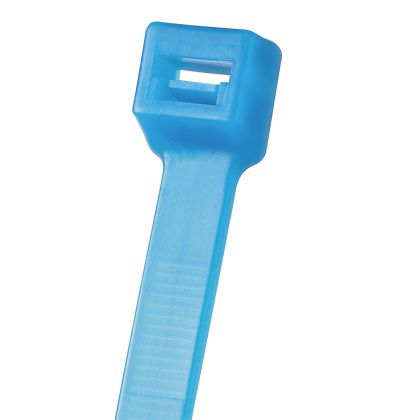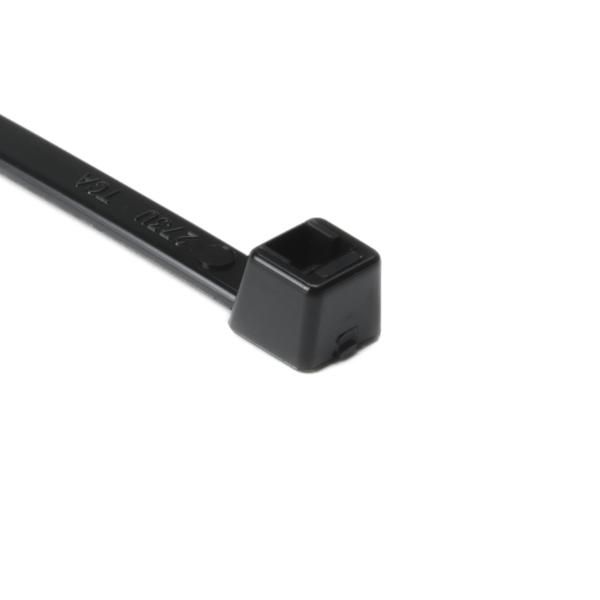Challenges of High Moisture Environments
In humid or wet conditions, cable ties face a variety of environmental stressors that can lead to premature failure. The most common challenges include:1. Water Absorption and Material Breakdown
 Standard nylon cable ties tend to absorb moisture, which weakens their tensile strength and flexibility over time. When exposed to humidity, nylon ties:
Standard nylon cable ties tend to absorb moisture, which weakens their tensile strength and flexibility over time. When exposed to humidity, nylon ties:
- Swell and become brittle, increasing the risk of breakage.
- Lose their locking strength, leading to slippage or loose bundling.
- Develop cracks and fractures, especially in fluctuating temperatures.
2. Corrosion and Rust Formation
Cable ties with metal locking mechanisms or exposed steel components can corrode when exposed to moisture, particularly in marine, offshore, and chemical processing industries.- Saltwater and humidity accelerate rust formation, weakening the structural integrity of the tie.
- Corrosion can also lead to contamination risks, especially in food processing, pharmaceutical, and medical applications.
3. Mold, Mildew, and Bacterial Growth
 In high-moisture environments, organic materials can promote fungal, bacterial, and mildew growth on plastic cable ties. This is a major concern in:
In high-moisture environments, organic materials can promote fungal, bacterial, and mildew growth on plastic cable ties. This is a major concern in:
- Food processing plants, where sanitation and hygiene are critical.
- Pharmaceutical and medical facilities, where contamination must be minimized.
- Marine environments, where constant exposure to water promotes biofouling.
4. Reduced Mechanical Strength in Extreme Conditions
 Some plastic cable ties degrade faster when exposed to temperature fluctuations, high humidity, or direct water contact. Issues include:
Some plastic cable ties degrade faster when exposed to temperature fluctuations, high humidity, or direct water contact. Issues include:
- Brittle failure in cold, wet environments.
- Softening or warping in high heat and moisture.
- Compromised locking strength, leading to unreliable fastening.
Best Materials for High Moisture Environments
The durability of a cable tie in humid or wet environments largely depends on the material composition. Below are the most reliable materials designed to withstand moisture, humidity, and chemical exposure.Best Materials for High Moisture Environments
Cable ties must withstand constant exposure to humidity, water, and temperature fluctuations in wet environments. Choosing the right material prevents corrosion, degradation, and loss of strength over time. Below are the most effective materials designed for high-moisture applications.
UV-Resistant and Weatherproof Nylon (Nylon 6/6)
Water Resistance and UV Protection
Nylon 6/6 resists water absorption, making it suitable for damp and humid environments. Unlike standard nylon, this material remains flexible and strong despite prolonged exposure to moisture. Manufacturers treat these ties with UV stabilizers, which prevent sunlight degradation and ensure durability in outdoor conditions.
Resistance to Mold and Mildew
High humidity promotes biological contamination such as mold and mildew. UV-resistant nylon ties offer moderate protection, reducing the risk of deterioration in industrial and commercial environments. This feature makes them ideal for HVAC systems, where temperature changes and condensation frequently occur.
Best Applications
Industries use weatherproof nylon ties in outdoor electrical installations, including telecommunications and power lines. They also provide a reliable bundling solution for general-purpose fastening in damp environments, ensuring long-term performance in exposed and humid conditions.
Stainless Steel Cable Ties (316-Grade Marine Steel)
Corrosion and Rust Resistance
Made from marine-grade 316 stainless steel, these cable ties resist corrosion and rust, even in saltwater environments. Unlike plastic alternatives, they withstand constant exposure to moisture, chemicals, and temperature fluctuations without weakening or breaking.
High Tensile Strength in Extreme Conditions
Stainless steel ties maintain locking strength and durability even in high-pressure washdowns, steam, and industrial sanitation procedures. Their mechanical integrity ensures secure bundling in high-vibration and high-moisture settings where plastic ties may fail.
Best Applications
Industries use stainless steel ties in marine vessels and offshore platforms, where salt exposure accelerates material breakdown. Chemical processing facilities and water treatment plants rely on their chemical resistance for securing cables in harsh environments. The food production and medical industries use them to comply with sanitation standards, ensuring contamination-free operations.
Fluoropolymer-Coated and PTFE Cable Ties
Moisture and Chemical Resistance
Fluoropolymer-coated and PTFE (Polytetrafluoroethylene) cable ties provide exceptional resistance to moisture, chemicals, and high temperatures. Unlike traditional nylon ties, they do not absorb water, ensuring stability in continuous high-humidity environments.
Anti-Microbial Properties for Hygienic Applications
These ties feature built-in microbial resistance, preventing mold, mildew, and bacterial growth. Industries that require strict hygiene control, such as pharmaceutical and food processing facilities, rely on these ties for sanitary fastening solutions.
Best Applications
Pharmaceutical manufacturers and cleanroom environments use PTFE-coated ties to maintain sterile conditions. Aerospace and aviation industries depend on them for chemical resistance, ensuring performance in fuel systems and high-heat applications. Industrial plants handling corrosive chemicals and solvents also prefer these ties for secure and long-lasting bundling.
Heat-Stabilized and Flame-Retardant Nylon
Moisture Resistance in High-Heat Environments
High-moisture settings often include extreme temperature fluctuations. Heat-stabilized and flame-retardant nylon cable ties resist steam, boiling water, and high-temperature exposure, making them essential for industrial and high-risk applications.
Compliance with Fire Safety Standards
These ties meet fire safety regulations, ensuring they do not contribute to combustion risks. Facilities that prioritize fire prevention use them to secure electrical and mechanical components in high-heat, high-moisture environments.
Best Applications
Industries rely on these ties in power plants and boiler rooms, where high humidity and heat coexist. Industrial kitchens and sterilization chambers require their resistance to steam and chemical exposure. In transportation and rail systems, where cables face fluctuating humidity and temperature changes, these ties provide long-term durability.
Selecting the Right Cable Tie for High-Moisture Applications
Best Applications for Moisture-Resistant Cable Ties
1. Marine and Offshore Industries
Cable ties in marine environments must withstand constant saltwater exposure, wind, and humidity. The best choices include:- 316 stainless steel ties for boat electrical wiring and deck rigging.
- UV-resistant nylon ties for outdoor applications exposed to rain.
2. Food Processing and Pharmaceutical Facilities
Moisture-resistant ties ensure compliance with FDA and HACCP standards by preventing mold and bacterial growth. The best choices include:- Fluoropolymer-coated ties for hygienic bundling of food production equipment.
- Stainless steel ties for securing conveyor belts and sanitation equipment.
3. Outdoor Installations and HVAC Systems
Outdoor applications require weatherproof and UV-resistant cable ties that can endure temperature fluctuations and humidity. Best choices include:- UV-stabilized nylon ties for securing cables on solar panels and power grids.
- Heat-resistant nylon ties for HVAC ductwork and rooftop installations.
4. Chemical and Wastewater Treatment Plants
Industrial plants that handle corrosive liquids and gases require chemically resistant, high-strength cable ties. The best options include:- Stainless steel ties for withstanding acid and caustic exposure.
- Fluoropolymer-coated ties for long-term durability in chemical processing plants.
